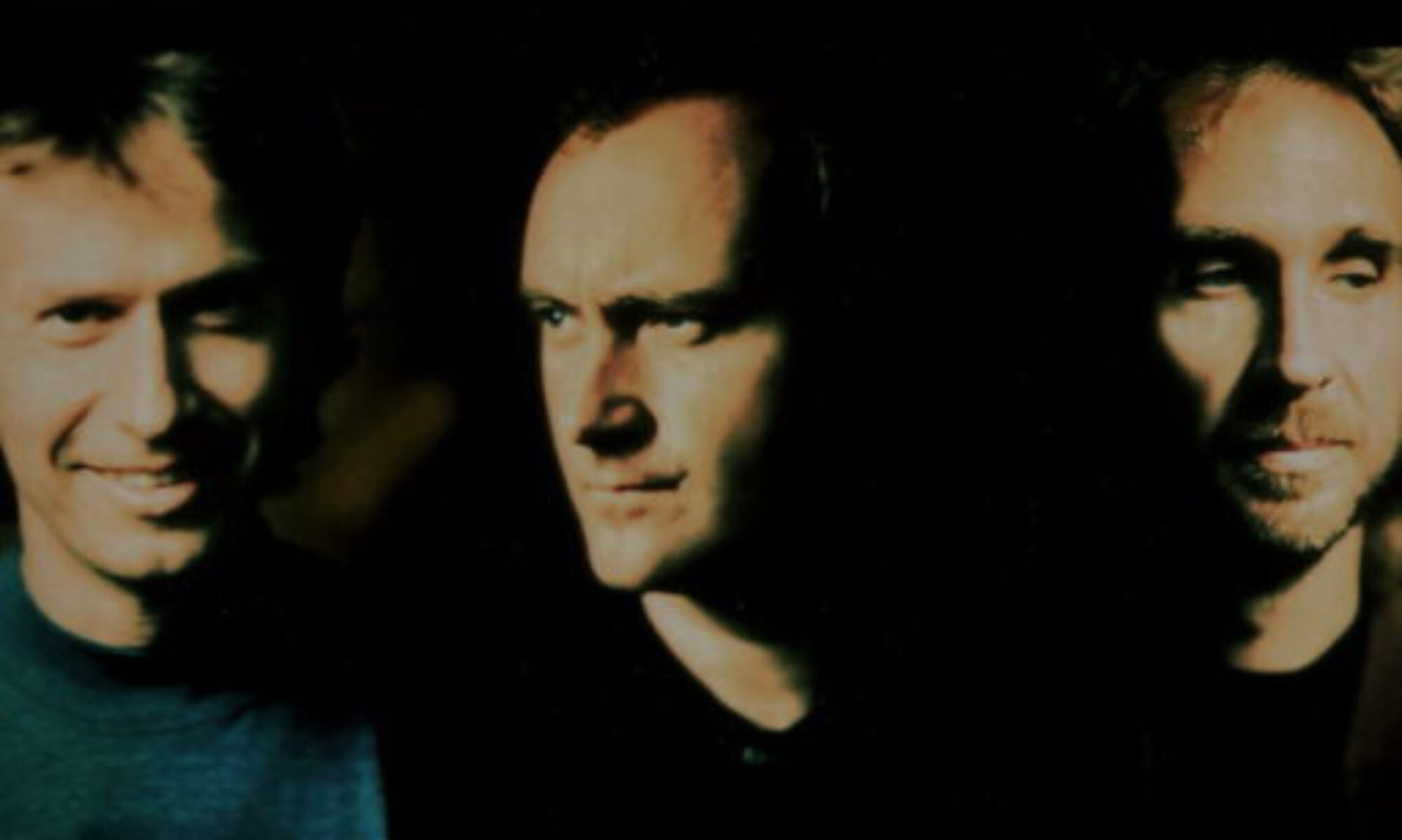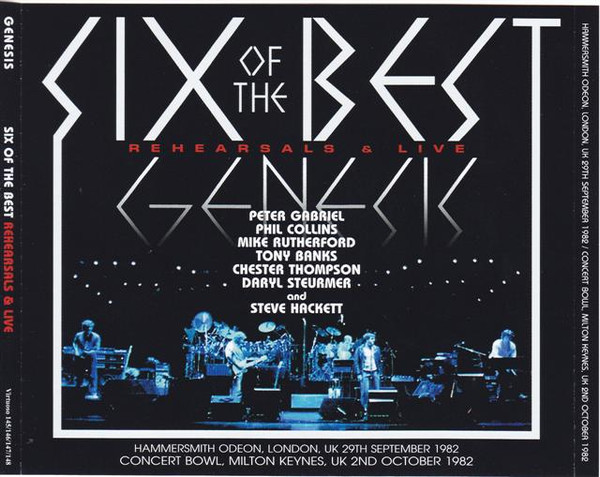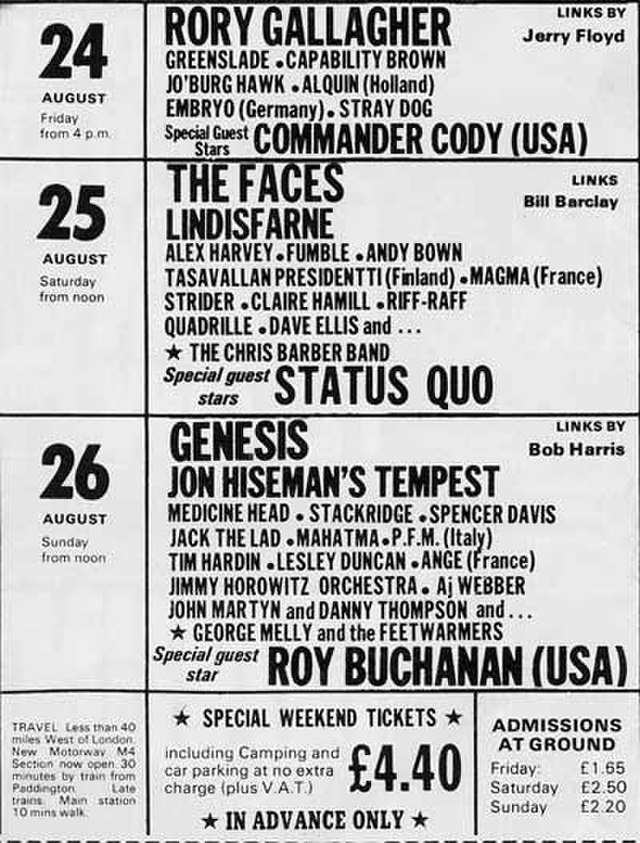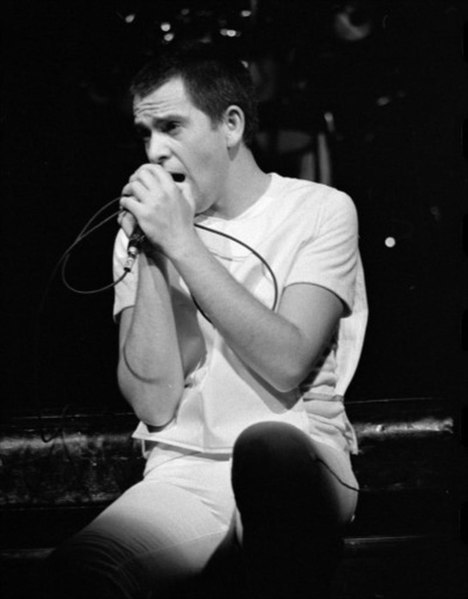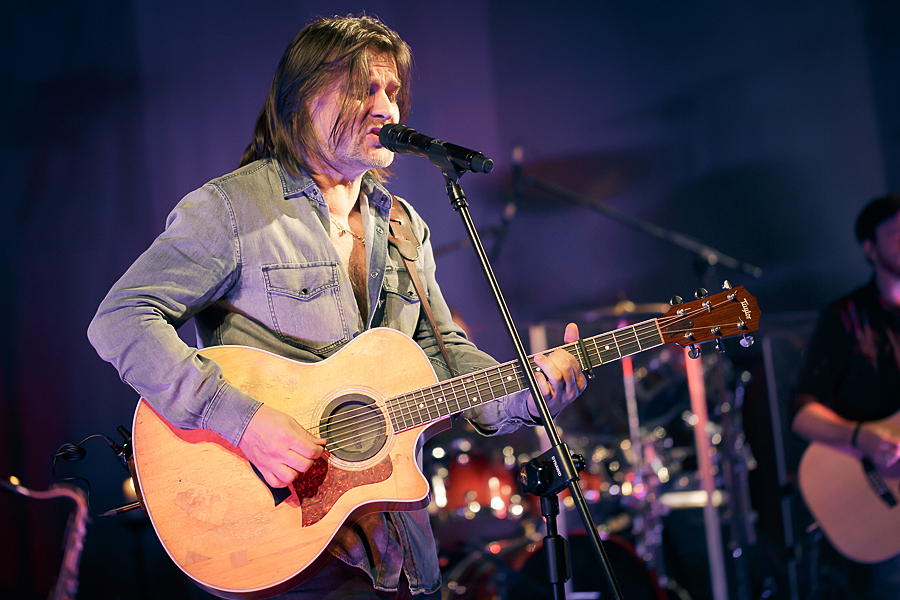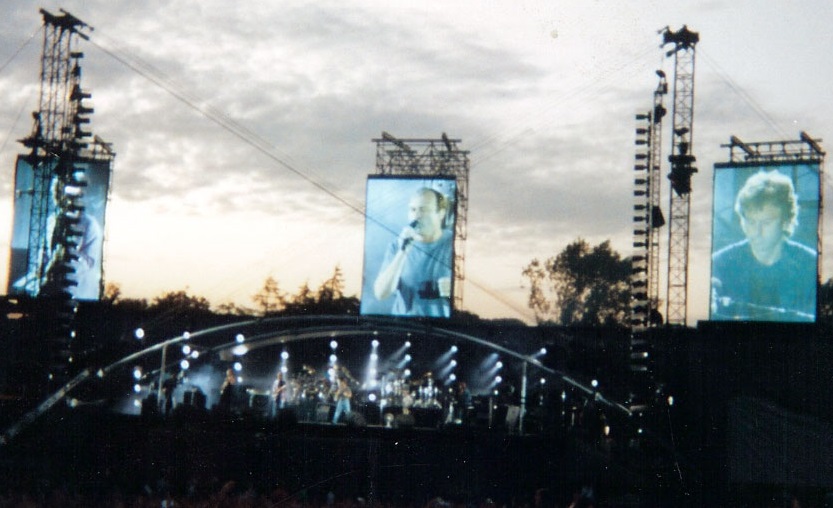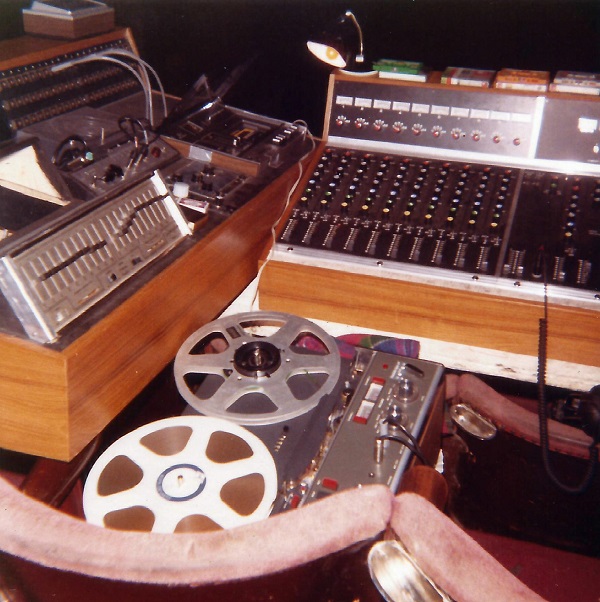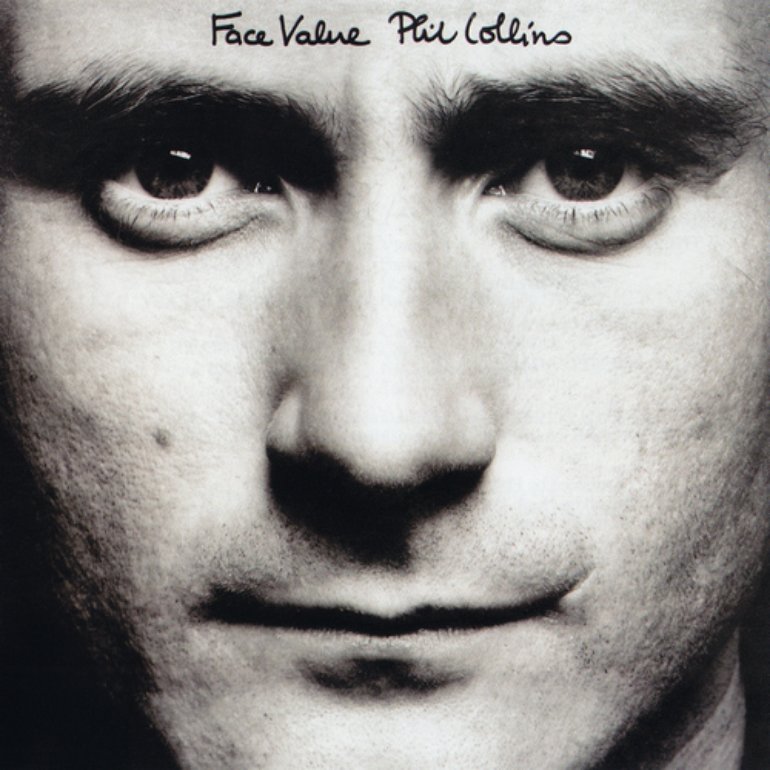On October 2, 1982, the legendary ‘Six Of The Best’ reunion show with Peter Gabriel and Genesis took place at Milton Keynes.
Continue reading “Six Of The Best”Genesis at Reading Festival 1971
Peter Gabriel performs with a broken ankle – and Genesis gain new fans
On 26 June 1971, Genesis performed at the Reading Festival for the very first time. Back then, they were still low on the bill, sharing the lineup with artists such as Lindisfarne, Terry Reid, Renaissance and Sha Na Na. Like many festivals, it came with its share of challenges: rain, mud, and even an unexpected police squad, but Genesis had a unique complication of their own: Peter Gabriel had recently broken his ankle.
The accident at Friars Club
Just a week earlier, on 19 June, Genesis had played a show at Friars in Aylesbury. During the encore of The Knife, Gabriel, always the theatrical frontman, leapt off the stage into the crowd. Unfortunately, the audience parted rather than caught him. He hit the floor hard and fractured his ankle.
Despite the injury, the band pressed on. Gabriel famously performed at least one subsequent gig in a wheelchair at an art college in Lincoln. Richard Macphail, Genesis’s tour manager and longtime friend, recalled the chaos:
‘And it scared the pants of me, because the stage was like a traditional theatre stage that sloped towards the audience. He was wildly cavorting in this wheelchair on this stage. I thought he was going to fall off the stage and break his neck!’1
Thankfully, he did not and just a few days later, Genesis took the stage at Reading.
Reading Festival in 1971
The 11th National Jazz and Blues Festival was held in Reading for the first time in 1971. The festival had previously moved between locations including Richmond, Windsor, Sunbury, and Plumpton due to local complaints. That year, it finally found a home in Reading, taking place at the Thames-side Arena on Richfield Avenue, over 25–27 June.
The event was rebranded as the Reading Festival of Folk and Progressive Music, with a ticket for Saturday, 26 June, priced at just £1.50. Although Reading Festival is typically held in August today, it’s unclear why it took place in June that year, perhaps due to the town’s 1000th anniversary celebrations, which had helped organizer Harold Pendleton gain approval from the local council.
Sharing the stage with Charisma labelmates
Genesis were not the only Charisma Records act at Reading in 1971. Lindisfarne, Van der Graaf Generator, Bell & Arc, and Audience also performed, alongside other notable names like Arthur Brown, Rory Gallagher, Wishbone Ash, Osibisa, and Ralph McTell.
Genesis played mid-afternoon on the festival’s second day. Despite their relatively low billing, their set was highlighted as one of the standout performances of the weekend. The impact was strong enough that they were invited back in the following two years.
A new era: Genesis and the festival circuit
That summer marked the beginning of Genesis’s appearances at outdoor rock festivals. Steve Hackett later recalled that it rained nearly every time they played an outdoor show in England or Europe, turning every venue into a mud bath.
At Reading, technical issues added to the frustration. Power fluctuations made it nearly impossible to keep instruments in tune. The organ was already difficult to manage, and the Mellotron, notorious for its fragility, was even worse. Their twelve-string guitars, tuned backstage, were often already out of tune by the time they hit the stage and tuning a twelve-string in front of a festival crowd was nearly impossible.
Not made for festivals?
Looking back, Tony Banks admitted that Genesis were not ideally suited for the festival scene in those early years. The broad daylight made it difficult to create a dramatic atmosphere, the audiences did not always appreciate the complex song structures, and sound quality was often poor.
Still, the band slowly built a reputation as a strong live act and festivals helped them reach new fans. The real magic, though, happened after dark, when they could perform for their own audiences in a controlled setting.
But even at this early stage, they were beginning to leave an impression. At Reading 1971, some fans in the crowd already waved Genesis flags, signaling that the band’s dedicated following was starting to take shape.
Photo: Reading Festival Line Up 1973. Reading-festivaalin vuoden 1973 esiintyjälista Source: Wikimedia Commons, National Jazz, Blues and Rock Festival. / CC-BY-SA-2.5 (https://creativecommons.org/licenses/by/3.0).
- Platts, Robin, Genesis. Behind the lines, 1967-2007. (Burlington, Ont., Canada: Collectors Guide Pub., 2007), p. 44. ↩︎
Genesis’ First Gig Abroad: Belgium, March 7, 1971
Genesis played their first-ever overseas concert on March 7, 1971, at La Ferme in Woluwe St. Lambert, Belgium. This landmark performance marked a significant step in the band’s journey, as they ventured beyond the UK for the first time.
Trespass Had Charted in Belgium
At the start of 1971, Genesis had yet to achieve major success in their home country. However, things were different on the continent: their second album, Trespass, had reached number one in Belgium. Encouraged by this unexpected success, the band – now featuring new members Phil Collins on drums and Steve Hackett on guitar – headed to Belgium for their first international show.
A Rough Journey Across the Channel
The band crossed the English Channel on an overnight ferry, but sleep was out of the question. Unable to afford cabins, they spent the night sitting on deck – while Phil, suffering from seasickness, spent most of it throwing up. Running on little more than beer and sandwiches, they arrived in Belgium the next morning, drove straight to the venue, and played.
The Setlist: A Mix of Old and New
The setlist featured songs from Trespass, live favorites, and two brand-new tracks. As was typical for Genesis at the time, the performance started with acoustic material before building up to heavier numbers. Fortunately, a recording of this historic gig exists, allowing us to hear most of the show (though some parts are missing). It also contains the only known live recording of the rare song “The Light”, which features early elements that would later evolve into The Lamb Lies Down on Broadway’s “Lilywhite Lilith.”
Opening with a New Song
The show began with the band’s latest composition, “Happy The Man” – introduced by Peter Gabriel as a song about a man who “eats his fingernails, probably.” Built around a Mike Rutherford riff, the song had a laid-back, folk-rock feel, reminiscent of Lindisfarne. It was an attempt at a radio-friendly single, and in this live version, it was performed at a slightly slower tempo.
Next came “Stagnation” from Trespass – which Gabriel jokingly described as being about “people with bad breath.” This live rendition, enhanced by Phil Collins’ drumming, had a swing that was missing from the studio version.
The Only Recorded Performance of “The Light”
After a few minutes of Peter’s humorous attempts to introduce the band, they launched into “The Light” – a rarity in Genesis’ catalog. The song’s opening bass riff would later be repurposed for “Lilywhite Lilith”, and Steve Hackett’s guitar parts would also find their way into that track. “The Light” then developed into a full-fledged progressive rock piece, featuring an extended instrumental jam between Tony Banks and Hackett. Eventually, the song returned to a section that closely resembled the later Lamb Lies Down classic. Compared to other Genesis compositions from this era, “The Light” stands out as a unique and intriguing experiment.
A Blend of Familiar and Unfinished Material
Next, the band slowed things down with “Twilight Alehouse”, a live staple at the time. The dramatic organ-driven climax showcased Tony Banks’ signature style. Then came another brand-new song: “The Musical Box”, which Peter introduced in both English and French. This early version was slightly different from the one that would appear on Nursery Cryme later that year. There was extra instrumental material before the “And the clock” section, which was repeated twice. Tony’s keyboard solo was extended, while Steve Hackett’s was shorter – unsurprising, as he had only been with the band for two months. Even the song’s now-iconic climax had subtle differences in Gabriel’s vocal delivery.
The band then launched into the Trespass classic “The Knife”, which Peter introduced in French. Tony’s organ led the charge, Mike Rutherford’s bass provided the driving force, and Steve Hackett – though still getting to grips with the song’s solos – delivered a strong performance by the end. Unfortunately, Peter’s flute section in the middle is missing from the recording. The audience, however, responded with enthusiasm, applauding loudly.
For the encore, Genesis performed “Going Out to Get You”, an early track that Peter described as “a very old number about passion.” Tony Banks dominated the piece, and Steve Hackett was barely audible – at times, it even seemed as if he wasn’t playing at all.
A Glimpse Into Genesis’ Creative Process
Listening to this rare recording is fascinating – not just because it includes unreleased songs, but also because it captures the band in the midst of developing their material, both musically and lyrically. Most notably, it features the only known live performance of “The Light”, making it an essential piece of Genesis history.
An Exhausting but Pivotal Moment
The concert was a success and a crucial milestone for Genesis. After the show, the exhausted band made their way back to the UK on the ferry, with Phil Collins limping home, nearly collapsing from sheer fatigue. Despite the rough journey, this first step into the international spotlight marked the beginning of Genesis’ rise as one of progressive rock’s most important bands.
Photo: FOH PA mixing desk and associated gear for Genesis at a concert in the Liverpool Empire, 1970s, precise year unknown. Source: Wikimedia Commons, Rodhullandemu / CC-BY-SA-2.5 (https://creativecommons.org/licenses/by/3.0).
Peter Gabriel’s First Solo Gig
Peter Gabriel’s first performance as a solo artist took place at the Capitol Theatre in Passaic, New Jersey, on either March 2, 3, or 5, 1977.
The Album and the Tour
His debut album, Peter Gabriel, had been released in February 1977 and featured the hit single “Solsbury Hill.” Just like the album, the tour carried the motto: Expect the Unexpected. Gabriel assembled a band of top studio musicians and old friends to bring his new music to life.
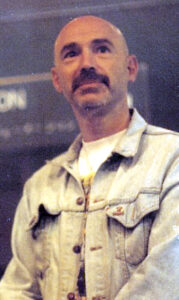
One of those musicians was Tony Levin on bass. Having already worked with artists like Paul Simon, Levin joined Gabriel for this tour and has been with him ever since. In fact, he remains the only musician from that first album who still plays with Gabriel today.
The rest of the lineup for the first gig and the initial leg of the tour included Allan Schwartzberg on drums, Larry Fast on synthesizers, Steve Hunter on guitars, Jimmy Maelen on percussion, and Phil Aaberg on keyboards.
A somewhat surprising addition to the tour was Robert Fripp, who had played on the album and joined as a live guitarist under the alias “Dusty Rhodes.” Fripp, known for his distaste for the traditional rock-tour experience, often positioned himself behind the amplifiers or even offstage. He preferred to be introduced as “the completely unknown Dusty Rhodes.”
When Was the First Show?
The exact date of Gabriel’s first solo performance remains uncertain, with sources citing March 2, 3, or 5. Regardless of the precise date, the opening of the show was both deliberate and striking. Gabriel took the stage alone, performing “Here Comes the Flood” with only his voice, piano, and Fripp’s guitar. It was a bold statement – shedding the elaborate masks and costumes of his Genesis days and presenting himself simply as a musician, dressed in jogging clothes.
The full band joined in for the second song, “On the Air,” with its driving synths instantly energizing the crowd. “Moribund the Burgermeister,” which some saw as a callback to his Genesis style, felt a bit rigid in its live rendition. But “Solsbury Hill,” his first solo hit, resonated with the audience, particularly with American fans who had discovered him through the song. Live, the tracks sounded less orchestrated than on the album – leaner, punchier, and more aggressive.
Surprising Cover Songs and a Relaxed Band
Alongside his solo material, Gabriel included a few unexpected cover songs in the set. Marvin Gaye’s “Ain’t That Peculiar” paid tribute to his love of soul music, while The Kinks’ “All Day and All of the Night” was performed with a raw, heavy edge. The mostly American backing band was not only professional but also visibly enjoying themselves – especially during the R&B cover. The atmosphere on stage was relaxed and playful, something that even well-established bands sometimes struggle to achieve live. Gabriel himself seemed to revel in the experience.
The Fans’ Expectations
For the encore, Gabriel returned to the stage in Rael’s signature leather jacket, jeans, and T-shirt to perform “Back in N.Y.C.” from The Lamb Lies Down on Broadway. He was well aware that fans expected both his solo material and some Genesis songs. Throughout the show, some attendees had expressed disappointment at the minimal staging and the exclusive focus on his solo work. However, when he launched into “Back in N.Y.C.,” the audience erupted, leaving them wanting more.
And they got it. Peter Gabriel went on to become a hugely successful solo artist with a unique and ever-evolving career. Looking back today, his time with Genesis is merely a footnote in a career that firmly established him as one of the most distinctive voices in music history.
Photo: Peter Gabriel, Chateau Neuf, Oslo, Norway. Description=Peter Gabriel at Chateau Neuf in Oslo, Norway on August 31st 1978 |Source=http://www.helgeoveras.com/gabriel.shtml |Date=August 31st 1978 |Author=Helge Øverås (https://creativecommons.org/licenses/by/3.0).
The ‘Turn It On Again’ Reunion Tour
On 11 June 2007, Genesis kicked off their long-awaited ‘Turn It On Again’ reunion tour in Helsinki, marking the official return of Phil Collins as lead vocalist.
The Reunion Announcement
On 7 November 2006, Tony Banks, Mike Rutherford and Phil Collins held a press conference to announce that Genesis would reunite for a European summer tour in 2007, followed by a North American leg in the autumn. It was the first time Collins had officially rejoined the band since leaving in 1996, despite a few brief appearances over the years.
Joining them on stage were longtime touring members Chester Thompson (drums) and Daryl Stuermer (guitar/bass), both of whom had not performed with Genesis since the We Can’t Dance Tour in 1992.
Rehearsing After 15 Years
The band’s first full show was scheduled for 11 June in Helsinki. With no new album to promote, Genesis had the freedom to revisit their extensive back catalogue. But rehearsing after a 15-year hiatus came with unexpected challenges.
Tony and Mike not only had to relearn many of the songs, they also had to transpose them to accommodate Phil’s deeper vocal range. Phil, in turn, had to reacquaint himself with lyrics, particularly those written by Tony Banks, which he had always found tricky. Songs like “Domino” and “Home By The Sea” with lines such as “Sheets of double glazing” or “Nylon sheets and blankets” had always tested his memory.
Listening back to past live performances, Phil noticed how often he had deviated from the original songs. For this tour, he made a conscious effort to stick to the original versions.
On top of that, he had to get back into Genesis drumming shape. While he had continued to play on solo tours, most notably during “In the Air Tonight”, tackling complex pieces like “Second Home By The Sea” required serious effort. Thankfully, Chester and Daryl were there to support the process, with Daryl even helping Tony and Mike remember their own parts.
Despite the time apart, the old chemistry was still intact. In fact, the dynamic between the three had improved. Tony and Mike had mellowed with age, while Phil had grown more serious. This allowed them to communicate more openly, discussing things they wouldn’t have dared bring up 15 years earlier.
The Setlist
Genesis had a vast library of music to choose from and the setlist reflected that. Fan favourites like “Follow You Follow Me”, “Invisible Touch”, “Mama”, and “I Can’t Dance” were all included.
One highlight was a heavier version of “Land of Confusion”, clearly influenced by Disturbed’s popular metal cover. It gave the song a modern edge and fresh energy.
The band also included more intricate tracks from the later years, such as “Domino” and “Home By The Sea”, two of Tony Banks’s personal favourites. They opened the show with a medley titled “Duke’s Intro”, combining the instrumental from “Behind the Lines” with a section of “Duke’s End”. It made for a powerful, dramatic opening that set the tone for the entire night.
Phil played more drums than he had on previous tours, and for “I Know What I Like”, he even brought back the iconic tambourine dance from 1976, something he had to rehearse again after years off.
Two surprises in the setlist were “Ripples”, from 1976’s A Trick of the Tail (Phil’s first album as lead vocalist), and a fragment of “Duke’s Travels”, which was folded into a medley. In fact, the set covered nearly every album from 1973 onwards. Each show ended on a high note with the emotional “Carpet Crawlers”, a beloved classic from The Lamb Lies Down on Broadway.
Behind the Scenes
Stage design for the tour was handled by the legendary Mark Fisher, while Patrick Woodroffe created a stunning lighting design. A massive screen behind the band displayed visuals tailored to each song, giving every track a unique atmosphere.
Nick Davis oversaw the live sound, and the band partnered with the Encore Series to offer high-quality soundboard recordings of every show, making each concert available to fans.
Opening Night in Helsinki
The tour kicked off in Helsinki on a warm summer night. The band delivered a flawless performance, the visuals hit every cue, and fans were thrilled to see Genesis live once again.
Phil would later reflect that while many had hoped for a new Genesis album, the ‘Turn It On Again’ tour felt more like a farewell than a comeback. The band continued through North America in the autumn before bringing the curtain down.
Looking back, all involved agreed: the best part of the tour wasn’t just the music, it was the joy of being back with old friends and laughing together again.
Photo: Genesis, ofwel: Phil Collins, Michael Rutherford, Tony Banks, Chester Thompson en Daryl Stuermer.}} |Source=Maikel Koek, via Wikiportrait |Date= |Author=Maikel Koek |Permission={{Wikiportrait|2008041010026495}} (https://creativecommons.org/licenses/by/3.0).
Ray Wilson Announced as New Genesis Frontman
On June 6, 1997, Tony Banks and Mike Rutherford announced the new lead singer of Genesis following Phil Collins’ departure: 28-year-old Ray Wilson.
When Phil Collins revealed in March 1996 that he would be leaving Genesis after 25 years, fans were eager to learn who would step into his shoes. Genesis had already weathered the departure of their original frontman, Peter Gabriel, back in 1975. Now, two decades later, Tony Banks (keyboards) and Mike Rutherford (guitars), the remaining founding members, were determined to carry on once more.
They began writing and recording new material, searching for a vocalist who could help them shape the band’s next chapter. Rumors swirled in the music press, speculating about possible replacements. Then, on June 6, 1997, it was official: Ray Wilson would be the new voice of Genesis.
Who is Ray Wilson?
Born in Dumfries, Scotland, on September 8, 1968, Ray had previously fronted the band Guaranteed Pure and was best known for his work with Stiltskin, whose hit single “Inside” reached number one in 1994, thanks in part to its use in a Levi’s commercial. So, while Ray wasn’t an unknown figure in music, the stylistic gap between Stiltskin and Genesis left both his fans and Genesis fans surprised and cautious.
Reflecting on the moment in the Songbook DVD, Ray recalled:
‘I was in my little studio writing songs. It was ten in the morning, I was making a coffee, and Tony Smith, the manager of Genesis, was on the phone: ‘Would you like to come and audition to replace Phil Collins?”
By then, Phil Collins’ massive solo success had blurred the public’s perception of Genesis. It was often seen as “Phil Collins and his band”. Taking over that role and shifting that image would be no easy task.
Calling All Stations
Ray joined Tony and Mike at The Farm, Genesis’ private studio in Surrey, to begin recording what would become Calling All Stations. Most of the songs had already been written by Banks and Rutherford, but Ray contributed several ideas of his own. The result was a darker, more melancholic record. The vibrant energy and accessible pop sensibility Phil had brought to the group were now absent, and with it, part of the familiar Genesis chemistry.
Still, Ray’s emotionally rich vocals suited the mood of the new material. His voice, more reminiscent of Peter Gabriel than Phil Collins, blended well with the brooding tone of the songs. Calling All Stations, like its predecessor We Can’t Dance, was produced by Nick Davis.
Three singles were released from the album: “Congo”, “Shipwrecked”, and “Not About Us”. Ray co-wrote the latter, along with “Small Talk” and “There Must Be Some Other Way.” Drums on the record were provided by Israeli session musician Nir Zidkyahu and Nick D’Virgilio from American prog-rock band Spock’s Beard.
Despite Ray’s strong performance, critics were less than kind. NME wrote dismissively that “the world doesn’t care enough about Genesis to make the effort” and claimed people had “forgotten why they were once any good.” Q magazine criticized the album for offering “just darkness, confusion, individual isolation,” calling it “one-paced and one-dimensional.”
Live in 1998: Ray on Tour
On tour, however, Ray proved his versatility. The setlist spanned the entire Genesis catalog from the pop-era hits like “Invisible Touch”, “No Son Of Mine”, and an acoustic version of “Follow You Follow Me”, to later epics such as “Home by the Sea”, and even classic Gabriel-era tracks like “Carpet Crawlers” and “The Lamb Lies Down on Broadway.” New material from Calling All Stations also held up well live. Some songs, like the title track, even sounded better on stage.
Ray, Mike, and Tony were joined on tour by Nir Zidkyahu on drums and Anthony Drennan on guitar and bass, effectively filling the shoes of Chester Thompson and Daryl Stuermer.
Commercial Struggles
Despite reaching No. 2 in the UK, Calling All Stations underperformed in the U.S., peaking at just No. 54. Ticket sales also fell short of expectations. As a result, the production and scale of the tour were scaled back and the planned American leg was cancelled entirely.
After the 1998 tour, Tony Banks and Mike Rutherford decided to put Genesis on indefinite hold.
Looking Back
Although this wasn’t the end of Genesis, in 1998 it certainly felt like it. And sadly, Ray Wilson, thrust into a difficult situation, was unfairly blamed by some critics and fans for the band’s lack of commercial success during this era.
But this criticism doesn’t hold up. Ray brought a unique voice and delivered both the new material and the classics whether originally sung by Peter Gabriel or Phil Collins with emotion and distinction.
Following the end of Genesis, Ray took time to regroup before launching a solo career. He has since released several solo albums and continues to perform live, often including Genesis songs in his setlists.
Title photo: Ray Wilson live in Dortmund in 2017 (Photo: André Wilms of ‘The Photography Of Mister Ilms)‘.
We Can’t Dance in Tampa – The Story of the 1992 Tour
Tampa, Florida, 17 May 1992. It was only the fourth night of Genesis’ massive We Can’t Dance tour when the band had to leave the stage early after just two songs. Phil Collins was suffering from throat problems, and the show was cancelled after Land of Confusion and No Son of Mine, leaving a restless crowd behind. Thankfully, it was a one-off incident. The We Can’t Dance tour would go on to become one of the band’s biggest productions ever, both in scale and ambition.
Let’s take a closer look at this monumental tour.
A Blockbuster Album: We Can’t Dance
Released in 1991, We Can’t Dance was Genesis’ 14th studio album and it became another global smash. Even after nearly 25 years in the business, the band were still topping charts around the world. The album spawned four hit singles: No Son of Mine, I Can’t Dance, Hold On My Heart, and Jesus He Knows Me. Each of them came with its own high-budget music video. I Can’t Dance and Jesus He Knows Me, in particular, stood out for their sharp humour and clever production.
Stadiums, Screens, and Scale: The We Can’t Dance Tour
Naturally, such a successful album deserved a tour to match. More than 60 shows were scheduled across North America and Europe in 1992. While Genesis weren’t entirely comfortable with stadium gigs, they ultimately preferred three months of large-scale shows over a ten-month arena tour. The goal was clear: keep the tour tight and efficient.
The production went up a notch: three massive Sony Jumbotron video screens were installed behind the stage, ensuring that fans even in the furthest rows could see the band up close. Rehearsals took place inside the enormous Goodyear Blimp hangar in Houston, one of the few places big enough to house the full setup.
The Setlist and the Line-Up
Tony Banks, Phil Collins, and Mike Rutherford were joined once again by their trusted touring musicians Chester Thompson (drums) and Daryl Stuermer (guitar and bass). After weeks of rehearsals, the setlist came together: mostly material from We Can’t Dance, along with select tracks from Invisible Touch and Genesis, and of course the classic encore Turn It On Again.
A 20-minute medley brought back highlights from the band’s 1970s output. It was a refreshing change from the long-standing In the Cage medley, which had featured in live shows for years.
Trouble in Tampa
The tour kicked off on 8 May 1992 in Texas. But disaster struck on night four in Tampa. Phil Collins’ voice simply gave out. He had always taken care of his voice while on tour, using various treatments when needed and he knew the crowd could sing along if he had to take it easy. But this time, he just couldn’t go on. After Land of Confusion and No Son of Mine, the band had no choice but to walk off stage.
Fortunately, Phil recovered quickly, and the rest of the tour went ahead as planned. The first leg concluded in August with a massive open-air concert at Knebworth Park, which was broadcast on Premiere. The second leg kicked off in the autumn, taking the band across the UK, a region they hadn’t toured extensively during the 1980s. They made up for it with multiple dates at London’s Earl’s Court, which were filmed and later released as The Way We Walk: Live in Concert.
The Way We Walk – Capturing the Tour
The tour also resulted in a live double album: Live – The Way We Walk, split into two volumes — The Shorts and The Longs. Rather than presenting an entire show in sequence, the band divided the material into their hit singles and their longer, progressive epics. Some fans didn’t love this format, but it made sense at the time: casual listeners knew the hits, while long-time fans appreciated the deeper cuts. Later editions of the album would restore the original running order.
The Last Dance (For a While)
Unbeknownst to fans and band members alike, the We Can’t Dance tour would be the last Genesis tour with Phil Collins until the 2007 reunion. It was also the final tour for Chester Thompson and Daryl Stuermer, at least for the next 15 years.
No one knew it at the time, but this was the end of an era. For many fans, 1992 was the last chance to see this iconic lineup live. But, as Genesis fans now know, there was more to come — eventually.
Title photo: Genesis Live- Land Of Confusion. Photo taken during the performance by Genesis of “Land of Confusion” in Knebworth, England (August 2nd, 1992). Source: Wikimedia Commons, Manny Hernandez/ CC-BY-SA-2.5 (https://creativecommons.org/licenses/by/3.0).
Live at the Roundhouse 1970
On March 11, 1970, Genesis played one of the most significant gigs of their early career at the Atomic Sunrise Festival at London’s legendary Roundhouse. The event, sponsored by Yoko Ono, featured artists such as David Bowie and Hawkwind. Just weeks later, Genesis signed their first major record deal with Charisma Records.
Genesis in Early 1970
At the start of 1970, Genesis were busy writing and rehearsing new material for their second album. Their debut album had failed to chart, and they had parted ways with producer Jonathan King and Decca Records. Determined to take a new direction, the band moved away from the pop-oriented style of their first record and embraced a more adventurous, experimental sound. At the time, Genesis consisted of: Peter Gabriel (vocals), Tony Banks (keyboards), Ant Phillips (lead guitar), Mike Rutherford (guitar and bass) and John Mayhew (drums).
Opening for David Bowie at the Roundhouse
Still an unknown band, Genesis saw the Atomic Sunrise Festival as a huge opportunity – especially since they were set to open for David Bowie.
Both Tony Banks and Peter Gabriel were big Bowie fans. Space Oddity had been released the previous year, and Bowie was already a rising star. His live shows at the time were highly theatrical, something that fascinated Gabriel. A few years later, Genesis would gain recognition for their elaborate stage performances, partly inspired by Bowie’s dramatic approach.
However, not everyone in the band was equally enthusiastic. While Gabriel was impressed by Bowie’s visuals, Banks felt that the theatrical elements took too much attention away from the music. This difference in perspective would later lead to tensions within Genesis, especially as Gabriel began incorporating costumes and masks into their own performances – something that divided opinions among the band.
The Atomic Sunrise Festival and Yoko Ono’s Involvement
At the Atomic Sunrise Festival, Genesis performed songs that would later appear on their second album, Trespass, including “Looking for Someone” and “The Knife” – both of which were captured in surviving video footage. It is also believed that they played “Twilight Alehouse”. In later interviews, Ant Phillips joked that this footage is the only visual proof that he ever performed with Genesis.
Despite the significance of the gig, the band’s experience was not entirely positive. Gabriel recalled that there were more people on stage than in the audience, and Phillips was so nervous that he could barely play – a stage fright that would later contribute to his decision to leave Genesis.
Still, both Banks and Phillips were impressed by the professionalism behind the scenes. Every performance at the festival was recorded on 8-track equipment, and parts of it were filmed. Since the event was backed by Yoko Ono, there’s a possibility that the full footage still exists somewhere in the Apple Records archives.
A few weeks after the show, Genesis signed with Charisma Records, and by the end of the year, they released Trespass. But changes were already on the horizon – Ant Phillips left the band, and a new drummer joined in the summer of 1970… but that’s a story for another time.
Title photo: Genesis mixing desk 2 – Revox A77 and associated gear for Genesis at a concert in the Liverpool Empire, 1970s, precise year unknown. Source: Wikimedia Commons, Rodhullandemu / CC-BY-SA-2.5 (https://creativecommons.org/licenses/by/3.0).
Face Value (1981) – Phil Collins
In February 1981, Phil Collins unveiled his debut solo album, Face Value, marking a significant departure from his role as Genesis’s frontman. The album not only showcased Collins’s personal and musical evolution but also cemented his status as a prominent solo artist in the 1980s.
Genesis and Personal Turmoil
By 1978, Collins had transitioned from Genesis’s drummer to its lead vocalist. The band’s 1978 album, …And Then There Were Three…, featured the hit “Follow You Follow Me,” signaling a shift towards more concise and direct songs. During this period, Collins faced personal challenges; his wife, Andrea, threatened to leave due to his extensive touring commitments. Upon returning from a tour, Collins discovered that Andrea had moved to Canada with their children. Despite efforts to reconcile, including a move to Vancouver, the marriage ended in divorce.
Creation of Face Value
In the aftermath of his divorce, Collins channeled his emotions into music. He set up a home studio in Surrey, equipped with a piano, drum machine, and an 8-track tape recorder. Here, he began crafting demos that delved into his personal experiences. When Genesis regrouped to work on their 1980 album, Duke, Collins presented some of these demos. Two tracks, “Misunderstanding” and “Please Don’t Ask,” were included in the album. Encouraged by the positive reception, Collins decided to pursue a solo project, collaborating with producer Hugh Padgham to develop his demos into a full-length album.
Musical Diversity and Notable Tracks
Face Value is a tapestry of various musical styles, reflecting Collins’s diverse influences. The opening track, “In the Air Tonight,” is renowned for its haunting atmosphere and the iconic drum break that has since become legendary. The song’s lyrics were largely improvised, capturing the raw emotion of the moment.
Another standout track, “I Missed Again,” introduces a brass section featuring the Phenix Horns, known for their work with Earth, Wind & Fire. This collaboration infused the song with a vibrant, funky energy, a sound that would become a hallmark of Collins’s future solo endeavors.
The album also explores a range of genres:
“The Roof Is Leaking”: A track with Delta blues and country influences, adding to the album’s eclectic nature.
“You Know What I Mean”: A poignant ballad showcasing Collins’s vulnerability, accompanied solely by piano and vocals.
“Hand in Hand”: An instrumental piece blending jazz and world music elements, highlighting the talents of the assembled musicians.
Commercial Success and Legacy
Upon its release, Face Value received critical acclaim and achieved significant commercial success. The album topped the UK Albums Chart for three weeks and reached No. 7 on the US Billboard 200. It has since sold over 5 million copies in the US and over 1.5 million in the UK. The success of Face Value not only established Collins as a solo artist but also set the stage for a series of successful albums throughout the 1980s.
In retrospect, Face Value stands as a testament to Phil Collins’s ability to translate personal adversity into a universally relatable and sonically diverse album. Its enduring appeal lies in its raw emotion, innovative production, and the seamless fusion of various musical styles.
Steve Hackett’s First Gig with Genesis: A Nervous Start to a New Era
On January 14, 1971, Genesis played a gig at University College, London, marking the live debut of their new guitarist, Steve Hackett. For Hackett, this night would become a memorable, albeit nerve-wracking, chapter in his career with the band.
Joining Genesis: A Classical Touch
Steve Hackett joined Genesis in late 1970, following an audition that showcased his unique style. Hackett brought a blend of classical, jazz, and blues influences, developed since his childhood in Pimlico. Inspired by The Beatles, Bach, and George Martin’s orchestrations, Hackett’s approach to guitar was more compositional than flashy—something Tony Banks and Peter Gabriel recognized during his audition. “We thought that some of what he did would fit really well,” Banks later recalled, praising Hackett’s classical edge.1
Before the audition, Hackett had advertised in Melody Maker for years and had gained limited recording experience with the band Quiet World. But when he joined Genesis, he knew this was his opportunity to make a lasting impact.
The Big Night: January 14, 1971
By the time Hackett stepped onstage for the first time as a member of Genesis, the band had already begun evolving into a cohesive unit. Phil Collins, who had joined a few months earlier, had quickly become a vital part of their sound. Mike Rutherford, having the dual roles on bass and rhythm guitar, was developing as a rhythm guitarist, while Peter Gabriel and Tony Banks remained the creative core.
The University College gig, however, was not an auspicious start. Hackett was understandably nervous, and the evening presented several challenges. Equipment problems—a recurring issue for Genesis in their early days—plagued the performance. Hackett’s borrowed fuzz box malfunctioned.
“I found his playing a little stiff”, Phil Collins later said, “but I guess that was the Fripp influence. I like Robert, I played with him on his solo album, he was always very good to me, but I don’t think he’s a very intuitive player. He was a kind of sound man without the feeling. I think Steve took a little bit of that into his music. It wasn’t a groove, you know, and as a drummer that was really where I lived.”2
Adding to the chaos on that first night, Collins decided to test the limits of his ability to drum after consuming Newcastle Brown Ale. According to Collins, “I was doing perfect drum fills – three inches to the left of every drum.”3 The resulting performance left the band frazzled.
Misunderstandings and Lessons Learned
Backstage, Hackett misinterpreted a heated discussion among the band members as criticism of his performance. In reality, Banks and Rutherford were admonishing Collins for his ale-induced drumming experiment. Sound mixer Richard MacPhail tried to reassure Hackett after the gig, leading him offstage after saying, “It’s over now, Steve.”4 Despite his doubts, Hackett’s contributions impressed the group, and they encouraged him to stay.
Building Momentum
The difficult debut was only the beginning. Hackett and Rutherford soon developed intricate ideas for their twin twelve-string guitars, which was a hallmark of Genesis’ sound. The band spent the rest of 1971 refining their music, writing and rehearsing material for what would become their first album with Hackett, Nursery Cryme. During the “Six Bob Tour” with Lindisfarne and Van der Graaf Generator, Genesis started gaining traction with audiences, performing in town halls and small venues across Britain.
By mid-1971, Genesis was playing bigger stages, including the Reading Festival and their first overseas gig in Belgium. Hackett’s insistence on acquiring a Mellotron MK II and new equipment pushed the band towards a more sophisticated sound.
A New Genesis
Hackett’s intricate guitar work and compositional mindset enriched Genesis’ music. Though his first gig was rocky, Hackett proved to be a vital addition to the band, helping shape their identity.
While that night at University College on January 14, 1971, may not have gone as planned, it set the stage for the musical evolution to come.
Title photo: Wikimedia Commons, Jeff Wurstner / CC BY (https://creativecommons.org/licenses/by/3.0)
Sources
Fielder, Hugh; Sutcliffe, Phil, The book of Genesis. (London: Sidgewick & Jackson, 1984).
PHIL COLLINS FULL 2-HOUR INTERVIEW: HIS CAREER WITH GENESIS TO 1980.
STEVE HACKETT FULL INTERVIEW- Revised : MY GENESIS YEARS.
TONY BANKS UNFILTERED: GENESIS KEYBOARD PLAYER & COMPOSER IN CONVERSATION . FULL.. 1 Hour 53 Mins.
